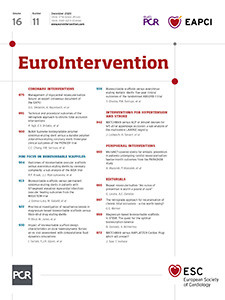
The addition of the retrograde technique to interventional strategies for percutaneous coronary intervention (PCI) of chronic total coronary occlusions (CTO) can be considered to be one of the major advances in PCI1. Its refinement took it from a very challenging technique in the beginning to a more predictable and structured approach2. A major driving force for the successful application of the retrograde approach was the concomitant development of microcatheters for the passage of the collaterals, and of speciality wires with very low tip load and high steerability to overcome even the most tortuous collateral connections, a development that is still continuing. In contemporary registries, the percentage of retrograde procedures which achieve high success rates is presently in the range of 30 to 40%3,4,5. However, the retrograde approach using the bilateral transcollateral access increases the complexity of the procedure and thus the potential risks involved6,7.
In the current edition of EuroIntervention, the paper by Tajti et al8, which provides a detailed analysis of complications associated with the retrograde approach as compared to the antegrade approach from the large PROGRESS-CTO registry, adds valuable information on the challenges associated with this more complex and demanding strategy.
The observation period of this registry was seven years with a changing number of participating centres throughout that period, which may have influenced the analysis. It is notable that the procedure and fluoroscopy times are rather long compared to contemporary registries3,4. Similarly to the above-mentioned registries, the retrograde approach was used in about one third of cases. The success rate of this approach decreased over the years despite no clear trend in lesion complexity, which is in contrast to other observations in contemporary registries3,4. This may be due to the participation of a variety of operators throughout the observation period, which is a weak point of this analysis.
The most distinct difference between this mainly US-based registry and data from Europe and Asia is the very high rate of post-coronary artery bypass graft (CABG) patients. These patients are at particular risk for complications and also have a lower success rate as compared to non-CABG patients9. This may partly explain the differences in procedure and fluoroscopy times. Given such a high prevalence of a particular risk group among the patient collective, specific care needs to be taken to make the retrograde approach as safe as possible.
The risk of perforation is increased with the retrograde approach as, in addition to higher lesion complexity, the passage of the wire and device through frail collateral channels adds an additional component of possible perforation complications. This requires a very careful approach to prevent them, and specific skills to deal with them. Localised deployment of coils, thrombin or fat is required to solve critical perforations, and sometimes it is necessary to deploy them from both the donor and receiver site of the collateral.
As perforations lead to a higher morbidity and mortality, every effort needs to be made to prevent them. If we look at the specific details presented in the current registry, there are issues which may be associated with a higher risk of perforation for the retrograde approach, especially in relation to the use of epicardial collaterals. The wires for the collateral passage were SION®, Fielder™ FC (both Asahi Intecc, Aichi, Japan) and Whisper® MS (Abbott Vascular, Santa Clara, CA, USA), of which only the SION is a dedicated wire with advanced tip control. The other two wires were most likely used for “surfing” the collaterals. While the “surfing technique” was ultimately successful, the study by Dautov et al10 on this specific approach also demonstrated that about one fourth of collaterals were perforated. Even if this event was minor in most cases, one cannot escape the obvious fact that it leads to increased perforations as compared to approaches with selective injection to navigate collaterals which have lower perforation rates3.
About one third of collateral attempts were epicardial connections. These collaterals should not be attempted by surfing as they are not “protected” by the myocardium as septal channels are. The preferred wires should be the SION and, although not available during PROGRESS-CTO, the SUOH 03 wire (Asahi Intecc) with exceptional qualities to pass the most tortuous connections. However, even more important for the risk of complications can be the microcatheter which follows the wire. Especially with epicardial connections, some of them are less distensible than others when a microcatheter follows the wire. Softer microcatheters, such as the more recent Caravel (Asahi Intecc), may be preferred to the more traditional Corsair (Asahi Intecc). The Caravel was in fact used with high prevalence in the present study. As this catheter became available only during the later years of the study period, the temporal use of the different devices may have changed.
It would be wrong to conclude from this study that the retrograde approach should be avoided as this would be to ignore one important fact that has been highlighted by this study – lesion complexity drives the required approach. Most of the patients in whom the CTO was opened because of the retrograde approach would have failed without this option, and procedural failure is a prognostic disadvantage11. It is therefore of the utmost importance to select patients carefully and make sure that they fulfil the clinical criteria to perform a CTO PCI, in terms of symptoms and large viable myocardial territories. Then they will benefit from even complex CTO procedures12.
Conflict of interest statement
The author has no conflicts of interest to declare.
Supplementary data
To read the full content of this article, please download the PDF.

